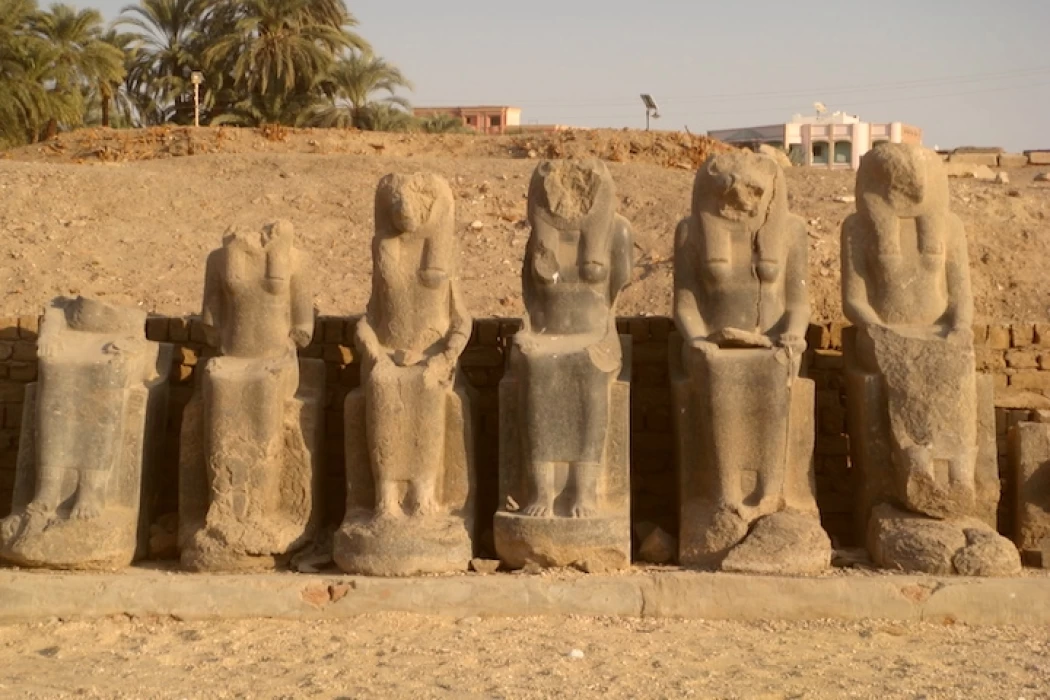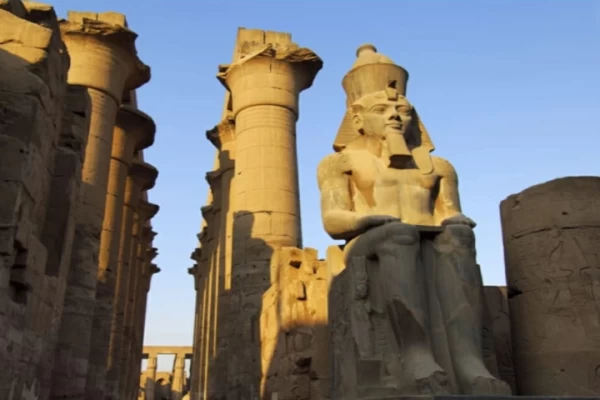
Temple of Mut | Precinct of Mut
The ancient temple is located 350 meters south of the Temple of Amun area in the Karnak Temple complex in Luxor, southern Egypt. You can reach it by rams at the tenth edifice until the end of King Ptolemy II's gate.
King Amenemhat the First is considered the first to build the foundations of the temple of the god Mut in the Middle Kingdom of the Pharaohs, and then King Amenhotep III builds the rest of the entire temple. Royal cartouches dating back to the era of King Thutmose II and King Thutmose III of the 18th Dynasty were discovered. King Ramesses II carved two statues and paintings from the marble in the temple. King Ramses III built the temple for himself, but it was used until the 25th Dynasty kings, then it became a quarry for the renovation and restoration of the temples in Karnak. In the Twenty-fifth Pharaonic Dynasty, the Kushite King Taharka built a sandstone gate and built a south-facing colonnaded portico, in addition to some buildings and restorations in the Temple of Mut itself. During the Ptolemaic era, King Ptolemy VI built a church inside the temple complex at Karnak.
A foot-tall statue of King Amenemhat the First was discovered, inscribed with dedicatory texts in the ancient Egyptian language, showing that the temple was built in the era of the Pharaonic king. A stone piece was discovered at the base of the statue of the priest Amenemhat Ankh. He was one of the priests of the temples of King Amenemhat III, one of the most famous kings of the Pharaohs throughout history. A statue of King Amenhotep the First, sitting on his knee, the god Mut, was discovered. Small statues of Habu Seneb and Wasan Mut were found from the era of Queen Hatshepsut. Stone slabs containing archaeological inscriptions from the era of King Thutmose III were found. A statue of the young Pharaonic king, King Tutankhamun, was found during excavations in the second courtyard. A life-size statue of Queen Tiye, wife of King Amenhotep III of the Pharaonic 21st Dynasty, made of granite, was discovered.
The temple is surrounded by a large wall that was built in the 30th Pharaonic Dynasty. You can reach the gate of the temple wall through the rams road at the tenth edifice in Karnak, which contains 130 statues of the ram-headed Sphinx, a symbol of the god Amun.
Inside the wall, you will see 6 Pharaonic temples, which are the main Temple of Mut, the Temple of King Ramses II, the Temple of King Ramses III, and two other temples.
In the northern direction, you will find a large edifice, which was built in the era of King Ptolemy II.
You will see another edifice that was built in the era of King Amenhotep III, and it was discovered that King Seti II and King Ramesses III restored the edifice and engraved the royal name on the edifice, in addition to a royal cartouche in the name of King Ptolemy VI.
After completing the first edifice, you will see an open courtyard that contained 10 columns with papyrus crowns in two rows, but the columns were destroyed and only a few are left of them now.
The courtyard follows the second edifice, but it is demolished, but the western tower was restored by the Brooklyn Museum mission in Germany. It is made of mud bricks, 3 meters high. A cartouche belonging to King Naqenbo I was discovered.
After the second edifice, there is another open courtyard, but it is currently demolished. It contained 4 square columns with Hathorian capitals on two rows. Statues of King Shashank I and King Tutankhamun and a cartouche of King Ramses II were discovered inside the courtyard.
After the second courtyard, we find the Hall of Columns, but it is currently demolished. It used to contain 8 columns in two rows.
At the end of the Temple of Mut, we find rooms that were intended for storing offerings and a room for the Holy of Holies that connects you to the sacred lake. A group of sandstone baboons statues was discovered on the western side of the temple.
Cairo day trips and Luxor day tours are two of the stunning trips we organize and that are very interesting to everyone visiting Egypt for the first time, as well as the beautiful Aswan excursions on which you will be guided by our Egyptologists while you will be amazed by the fascinating beauty of the Egyptian civilization, visit our travel information section that is meant to be useful for all the clients before booking. Our accredited guides will be your key to enjoying Egypt's best tours to explore the hidden mysteries of the glorious history of Egypt, as well as enjoy the lovely ancient Nile Valley, which has always been the source of generosity to the Egyptians.
There is an amazing museum in Luxor called the Mummification Museum. It is a special place where you can learn about how people used to live in Egypt a long time ago. You can even pretend that you are there with them and see all the incredible things they had during that time.















